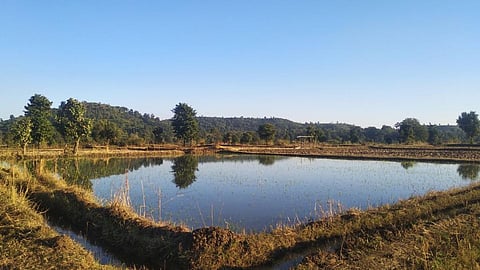
- Topics
- Feature
- Opportunities & Events
- About
- Hindi Portal
- Data
- Topics
- Feature
- Opportunities & Events
- About
- Hindi Portal
- Data

The village of Urdali is a predominantly rain-fed area, belonging to the Deelwara Gram Panchayat, in Bichhiya Block, Mandla District, Madhya Pradesh. In 1981-82, the irrigation canals connected to the then newly constructed Bichhiya dam supplied water to Urdali on a pilot basis, but the supply stopped within a year.
Located approximately 6-8 km from Bichhiya town, the only other time Urdali received any water from the dam was in 2013-14. It was a sub-canal built later and diverted through the village that ensured water the second time around. But this too was short-lived; sub-standard construction of the canal, built to provide water to villages around Bichhiya, soon became dysfunctional and disrupted the village’s only water supply from the dam.
For the 109 households of the village, this posed a huge problem since there was no other irrigation mechanism in place. Furthermore, all official records indicated that the entire village was under irrigation by the canals connected to the Bichhiya dam. The villagers submitted multiple complaints and petitions to the Mandla Collector and the Irrigation Department, to repair the canal over the years, but their concerns continued to be unaddressed. Recognizing their right to access water, the village leaders decided to take matters into their own hands.
Together with the Gram Paryavaran Samiti (the village institution) and the Foundation for Ecological Security (FES), they discussed ways to revive the canal so that water could reach their village. It was decided to come together, pick up their shovels, and through shramdaan (voluntary community labour), do what was required to revive the mud-filled canal. However, the villagers were sceptical about their long labours bearing any fruit.
As a result, they responded to this decision with muted enthusiasm and reluctant participation. However, with the local youth's support, the Samiti mobilized the community and ensured that every household in the village contributed towards reviving the canal. Eventually, people saw merit in contributing to the cause and their collective efforts revived the canal structure, bringing water to the village and transforming their farmlands into arable acreage throughout the year.
Post the revival of the canal, the village community realized it was also critical to ensure the structure’s strength and longevity, to avoid a relapse of damage. In order to address this, the villagers submitted another petition for concrete canal lining.
The FES team supported them and worked closely with the village administration to process these petitions. They provided guidance on the resolution process, helped develop the same and made travel arrangements for relevant meetings with concerned officials. This time around, the officials considered the community’s pleas. With the required approvals, the work of lining the canal was carried out by the Irrigation Department.
As a result of their collective efforts, the Urdali community cultivates both kharif and rabi crops, with water being available throughout the year. The Samiti has established rules to ensure equitable distribution of water as well; as per the rules, water delivered through the canal is provided to fields furthest away initially, making sure that every farmer in the village has access to and receives enough water for irrigation.
The Samiti also reached an understanding with the neighbouring village of Bundelikho over water diversion and usage. The agreement to divert water to the neighbouring village lands only after Urdali’ lands were well irrigated helped resolve minor conflicts and fostered amicable relations between the two villages.
"To a great extent, we have created the canal on our own. It has made a lot of difference to our agricultural fields. There is still some pending work; if we can make sub-channels, around 60-70 village farmers will further benefit from the water accessibility. Since we have shown that we can do this work on our own, we now expect the government to support us in the canal's extension,” says Ramlal Nareti, Gram Paryavaran Samiti Secretary, Urdali village.
The increased supply of water may not have shifted the Urdali community’s crop choices, but has significantly increased the area under cultivation. Of the total cultivable area of 300+ acres, the area for the kharif crop has now increased by 20%-30%. As for rabi crops, 150 acres cultivated earlier has now significantly increased by almost 90%.
Previously, 90%-100% of the cultivation was single crop and rainfed. With water available throughout the year, approximately 70% of Urdali’s farmlands now fall under double cropping. Where earlier the focus was mainly on kharif crops like paddy, the lands now also witness the cultivation of pulses and wheat in the rabi season. Previously, this would have been possible only if the soil contained adequate moisture content.
After witnessing the benefits of well-managed commons on their livelihoods, the community is well motivated to further undertake and adopt such efforts. The FES team is now working with them to undertake sustainable agriculture practices, which will ensure efficient water usage and crop choices, benefiting the community and the ecosystem as a whole.
Edited by Sahana Srinath and Kiran Singh from Foundation for Ecological Security.